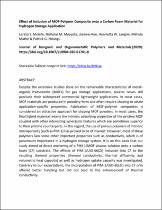 ResearchSpace
ResearchSpace
Effect of inclusion of MOF-polymer composite onto a carbon foam material for hydrogen storage application
JavaScript is disabled for your browser. Some features of this site may not work without it.
- ResearchSpace
- →
- Research Publications/Outputs
- →
- Journal Articles
- →
- View Item
| dc.contributor.author |
Molefe, Lerato Y

|
|
| dc.contributor.author |
Musyoka, Nicholas M

|
|
| dc.contributor.author |
Ren, Jianwei

|
|
| dc.contributor.author |
Langmi, Henrietta W

|
|
| dc.contributor.author |
Mathe, Mahlanyane K

|
|
| dc.contributor.author |
Ndungu, PG

|
|
| dc.date.accessioned | 2020-10-29T08:34:36Z | |
| dc.date.available | 2020-10-29T08:34:36Z | |
| dc.date.issued | 2020-08 | |
| dc.identifier.citation | Molefe, L.Y. et al. 2020. Effect of inclusion of MOF-polymer composite onto a carbon foam material for hydrogen storage application. Journal of Inorganic and Organometallic Polymers and Materials, vol. 173: https://doi.org/10.1007/s10904-020-01701-8 | en_US |
| dc.identifier.issn | 1574-1443 | |
| dc.identifier.issn | 1574-1451 | |
| dc.identifier.uri | https://doi.org/10.1007/s10904-020-01701-8 | |
| dc.identifier.uri | https://rdcu.be/b9bua | |
| dc.identifier.uri | https://link.springer.com/article/10.1007/s10904-020-01701-8 | |
| dc.identifier.uri | http://hdl.handle.net/10204/11648 | |
| dc.description | Copyright: 2020 Springer. Due to copyright restrictions, the attached PDF file only contains the abstract version of the full-text item. For access to the full-text item, please consult the publisher's website. The definitive version of the work is published at: https://doi.org/10.1007/s10904-020-01701-8 . A free full-text non-print version of the published item can be viewed at https://rdcu.be/b9bua | en_US |
| dc.description.abstract | Despite the extensive studies done on the remarkable characteristics of metal–organic frameworks (MOFs) for gas storage applications, several issues still preclude their widespread commercial lightweight applications. In most cases, MOF materials are produced in powdery form and often require shaping to attain application-specific properties. Fabrication of MOF-polymer composites is considered an attractive approach for shaping MOF powders. In most cases, the final hybrid material retains the intrinsic adsorbing properties of the pristine MOF coupled with other interesting synergistic features which are sometimes superior to their pristine counterparts. In this regard, the use of porous polymers of intrinsic microporosity (such as PIM-1) has proved to be of interest. However, most of these polymers lack some other important properties such as conductivity, which is of paramount importance in a hydrogen storage system. It is on this basis that our study aimed at direct anchoring of a PIM-1/MOF viscous solution onto a carbon foam (CF) substrate. The effects of PIM-1/UiO-66(Zr) inclusion into CF to the resulting thermal properties (thermal conductivity, thermal diffusivity and volumetric heat capacity) as well as hydrogen uptake capacity was investigated. Contrary to our expectations, the incorporation of PIM-1/UiO-66(Zr) into CF only offered better handling but did not lead to the enhancement of thermal conductivity. | en_US |
| dc.language.iso | en | en_US |
| dc.publisher | Springer | en_US |
| dc.relation.ispartofseries | Worklist;23852 | |
| dc.subject | Carbon foam | en_US |
| dc.subject | Hydrogen storage | en_US |
| dc.subject | Metal organic frameworks | en_US |
| dc.subject | Polymers of intrinsic microporosity | en_US |
| dc.title | Effect of inclusion of MOF-polymer composite onto a carbon foam material for hydrogen storage application | en_US |
| dc.type | Article | en_US |
| dc.identifier.apacitation | Molefe, L. Y., Musyoka, N. M., Ren, J., Langmi, H. W., Mathe, M. K., & Ndungu, P. (2020). Effect of inclusion of MOF-polymer composite onto a carbon foam material for hydrogen storage application. http://hdl.handle.net/10204/11648 | en_ZA |
| dc.identifier.chicagocitation | Molefe, Lerato Y, Nicholas M Musyoka, Jianwei Ren, Henrietta W Langmi, Mahlanyane K Mathe, and PG Ndungu "Effect of inclusion of MOF-polymer composite onto a carbon foam material for hydrogen storage application." (2020) http://hdl.handle.net/10204/11648 | en_ZA |
| dc.identifier.vancouvercitation | Molefe LY, Musyoka NM, Ren J, Langmi HW, Mathe MK, Ndungu P. Effect of inclusion of MOF-polymer composite onto a carbon foam material for hydrogen storage application. 2020; http://hdl.handle.net/10204/11648. | en_ZA |
| dc.identifier.ris | TY - Article AU - Molefe, Lerato Y AU - Musyoka, Nicholas M AU - Ren, Jianwei AU - Langmi, Henrietta W AU - Mathe, Mahlanyane K AU - Ndungu, PG AB - Despite the extensive studies done on the remarkable characteristics of metal–organic frameworks (MOFs) for gas storage applications, several issues still preclude their widespread commercial lightweight applications. In most cases, MOF materials are produced in powdery form and often require shaping to attain application-specific properties. Fabrication of MOF-polymer composites is considered an attractive approach for shaping MOF powders. In most cases, the final hybrid material retains the intrinsic adsorbing properties of the pristine MOF coupled with other interesting synergistic features which are sometimes superior to their pristine counterparts. In this regard, the use of porous polymers of intrinsic microporosity (such as PIM-1) has proved to be of interest. However, most of these polymers lack some other important properties such as conductivity, which is of paramount importance in a hydrogen storage system. It is on this basis that our study aimed at direct anchoring of a PIM-1/MOF viscous solution onto a carbon foam (CF) substrate. The effects of PIM-1/UiO-66(Zr) inclusion into CF to the resulting thermal properties (thermal conductivity, thermal diffusivity and volumetric heat capacity) as well as hydrogen uptake capacity was investigated. Contrary to our expectations, the incorporation of PIM-1/UiO-66(Zr) into CF only offered better handling but did not lead to the enhancement of thermal conductivity. DA - 2020-08 DB - ResearchSpace DP - CSIR KW - Carbon foam KW - Hydrogen storage KW - Metal organic frameworks KW - Polymers of intrinsic microporosity LK - https://researchspace.csir.co.za PY - 2020 SM - 1574-1443 SM - 1574-1451 T1 - Effect of inclusion of MOF-polymer composite onto a carbon foam material for hydrogen storage application TI - Effect of inclusion of MOF-polymer composite onto a carbon foam material for hydrogen storage application UR - http://hdl.handle.net/10204/11648 ER - | en_ZA |





